
The American goldfinch is a small North American bird in the finch family. It is migratory, ranging from mid-Alberta to North Carolina during the breeding season, and from just south of the Canada–United States border to Mexico during the winter.

Bird feeding is the activity of feeding wild birds, often by means of a bird feeder. With a recorded history dating to the 6th century, the feeding of wild birds has been encouraged and celebrated in the United States and United Kingdom, with it being the United States' second most popular hobby having National Bird-Feeding Month congressionally decreed in 1994. Various types of food are provided by various methods; certain combinations of food and method of feeding are known to attract certain bird species.
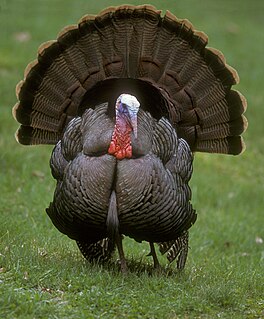
The wild turkey is an upland ground bird native to North America, one of two extant species of turkey, and the heaviest member of the order Galliformes. It is the ancestor to the domestic turkey, which was originally derived from a southern Mexican subspecies of wild turkey. Although native to North America, the turkey probably got its name from the domesticated variety being imported to Britain in ships coming from the Levant via Spain. The British at the time therefore associated the wild turkey with the country Turkey and the name prevails. An alternative theory posits that another bird, a guinea fowl native to Madagascar introduced to England by Turkish merchants, was the original source, and that the term was then transferred to the New World bird by English colonizers with knowledge of the previous species.
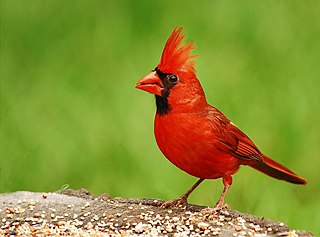
The northern cardinal is a bird in the genus Cardinalis; it is also known colloquially as the redbird, common cardinal, red cardinal, or just cardinal. It can be found in southeastern Canada, through the eastern United States from Maine to Minnesota to Texas, New Mexico, southern Arizona, southern California, and south through Mexico, Belize, and Guatemala. It is also an introduced species in a few locations such as Bermuda and Hawaii. Its habitat includes woodlands, gardens, shrublands, and wetlands.

The mountain bluebird is a small migratory thrush that is found in mountainous districts of western North America. It has a light underbelly and black eyes. Adult males have thin bills and are bright turquoise-blue and somewhat lighter underneath. Adult females have duller blue wings and tail, grey breast, grey crown, throat and back. In fresh fall plumage, the female's throat and breast are tinged with red-orange, brownish near the flank contrasting with white tail underparts. Their call is a thin 'few'; while their song is warbled high 'chur chur'. It is the state bird of Idaho and Nevada. It is an omnivore and it can live 6 to 10 years in the wild. It eats spiders, grasshoppers, flies and other insects, and small fruits. The mountain bluebird is a relative of the eastern and western bluebirds.
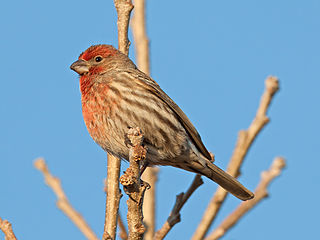
The house finch is a bird in the finch family Fringillidae. It is native to western North America and has been introduced to the eastern half of the continent and Hawaii. This species and the other "American rosefinches" are placed in the genus Haemorhous.

A birdfeeder, bird table, or tray feeder are devices placed outdoors to supply bird food to birds. The success of a bird feeder in attracting birds depends upon its placement and the kinds of foods offered, as different species have different preferences.

A bird bath is an artificial puddle or small shallow pond, created with a water-filled basin, in which birds may drink, bathe, and cool themselves. A bird bath can be a garden ornament, small reflecting pool, outdoor sculpture, and also can be a part of creating a vital wildlife garden.
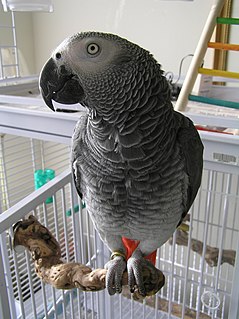
A companion parrot is a parrot kept as a pet that interacts abundantly with their human counterpart. Generally, most species of parrot can make excellent companions.

The rainbow lorikeet is a species of parrot found in Australia. It is common along the eastern seaboard, from northern Queensland to South Australia. Its habitat is rainforest, coastal bush and woodland areas. Six taxa traditionally listed as subspecies of the rainbow lorikeet are now treated as separate species.

Birds & Blooms is an American magazine about backyard plants, birds, butterflies, and other creatures.
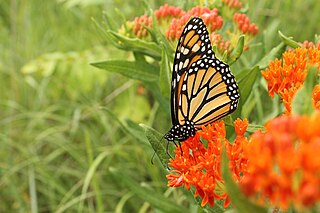
Butterfly gardening is a way to create, improve, and maintain habitat for lepidopterans including butterflies, skippers, and moths. Butterflies have four distinct life stages—egg, larva, chrysalis, and adult. In order to support and sustain butterfly populations, an ideal butterfly garden contains habitat for each life stage.

Bird food or bird seed is food consumed by wild and domestic birds. While most bird food is fed to commercial fowl, people also use bird food to feed their pet birds or provide a feeding site for wild birds.

The white-winged dove is a dove whose native range extends from the Southwestern United States through Mexico, Central America, and the Caribbean. They are large for doves, and can be distinguished from similar doves by the distinctive white edge on their wings. They have a blue eyering, and red eyes. The plumage is brownish-gray to gray. Juveniles are duller in color, and have brown eyes. The call is likened to English phrase "who cooks for you". There are three subspecies. It was first described by George Edwards in 1743, and given its binomial name by Linnaeus in 1756. It was moved into the genus Zenaida in 1838.
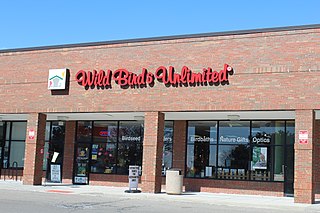
Wild Birds Unlimited is a retail store that specializes in bird seed, bird feeders, and many other bird feeding supplies. Jim Carpenter opened the first Wild Birds Unlimited store in 1981 in Indianapolis, Indiana. By 1983, Carpenter started franchising his concept. Wild Birds Unlimited has grown to over 300 stores across the United States and Canada.

The spiny-cheeked honeyeater is the only species in the genus Acanthagenys. It is large, for a honeyeater, ranging from 22 to 27 centimeters and weighing around 52 grams. The birds are sociable, aggressive, and often observed foraging in large flocks.
WildBird was a bimonthly magazine about birding or birdwatching in North America, Central America and South America. It was published by BowTie Inc.
The National Bird-Feeding Society (NBFS) is an organization in the United States whose mission is to make the hobby of bird feeding better, both for people who feed wild birds and for the birds themselves. To fulfill its mission, the NBFS conducts research and promotes education on wild bird feeding
The Wild Bird Centers of America, Inc., is a national franchisor of wild bird specialty retail stores. Most stores offer educational programs to the general public including bird walks and seminars with local experts.

The pinyon jay is a jay between the North American blue jay and the Eurasian jay in size. The voice is described as a rhythmic krawk-kraw-krawk repeated two or three times. It is the only member of the genus Gymnorhinus. Its overall proportions are very nutcracker-like and indeed this can be seen as convergent evolution as both birds fill similar ecological niches. The pinyon jay is a bluish-grey coloured bird with deeper head colouring and whitish throat with black bill, legs and feet.

















